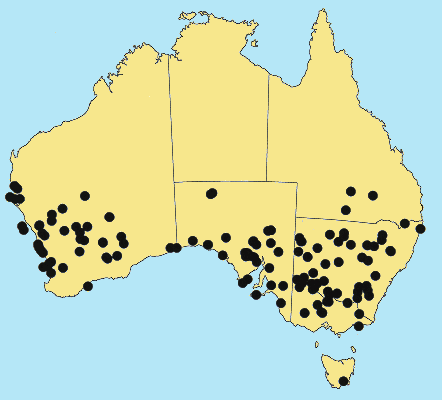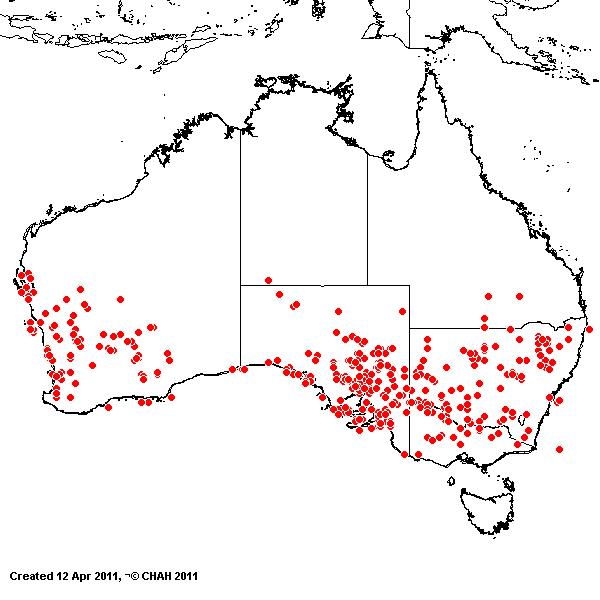Bromus arenarius Labill. Nov.
Holl. Pl. 1: 23 (1804).
Classification. (GPWG 2001) : Subfamily Pooideae.
Tribe Bromeae.
Type of Basionym or
Protologue Information: Hab. in terrâ Von, Leuwin .
Recent synonyms:
B. japonicus.
Key references
(books and floras): [1810]. R.Brown, Prodromus (178), [1878]
G.Bentham, Flora Australiensis 7 (661), [1952] C.A.Gardner, Flora of
Western Australia 1 Gramineae (96 as Serrafalcus patulus,
Serrafalcus arenarius), [1981] M.Lazarides in J.Jessop (ed)., Flora of
Central Australia (432), [2002] D.Sharp & B.K.Simon, AusGrass,
Grasses of Australia, [2002] J.Wheeler, N.Marchant & M.Lewington, Flora
of the South West (406), [2006] J.Jessop, G.R.M.Dashorst, F.M.James, Grasses
of South Australia (254), [2008] S.W.L.Jacobs, R.D.B.Walley &
D.J.B.Wheeler, Grasses of New South Wales (174), [2009] A.Wilson (ed.). Flora
of Australia, Vol 44A. Poaceae 2 (82).
Illustrations:
[2006] J.Jessop, G.R.M.Dashorst, F.M.James, Grasses of South Australia (255, Fig. 196 & plate 7), [2008]
S.W.L.Jacobs, R.D.B.Whalley & D.J.B.Wheeler, Grasses of New South Wales,
4th edn (174), [2009]. A.Wilson (ed.), Flora of Australia 44A: Poaceae
2 (84, Fig. 12).
Habit.
Perennial. Culms erect or geniculately ascending, 4–75 cm tall. Mid-culm
internodes glabrous or pubescent. Mid-culm nodes pubescent. Leaf-sheaths hairy.
Ligule an eciliate membrane. Leaf-blades 4–24 cm long, 1–7 mm wide. Leaf-blade
surface glabrous or indumented.
Inflorescence.
Inflorescence compound, a panicle. Panicle pyramidal, 2.8–18 cm long.
Spikelets.
Spikelets pedicelled. Fertile spikelets many flowered, with at least 2 fertile
florets (4–14), comprising 4–14 fertile floret(s), with diminished florets at
the apex, lanceolate, laterally compressed, 13–45 mm long.
Glumes. Lower
glume lanceolate, membranous, without keels or keeled, (1–)3–4(–5) -nerved.
Lower glume surface indumented. Upper glume lanceolate, (7.8–)8–11.5 mm long,
membranous, without keels or keeled, 5–7(–9) -nerved. Upper glume surface
indumented.
Florets.
Fertile lemma 9.3–18 mm long, without keel, 7 -nerved. Lemma apex dentate,
awned, 1 -awned. Median (principal) awn subapical or dorsal, (6.5–)9–15 mm long
overall. Lodicules present. Anthers 3.
Continental
Distribution: Australasia and North America.
Australian
Distribution: Western Australia, South Australia, Queensland, New South
Wales, Victoria, Tasmania.
Western Australia:
Carnarvon, Austin. Eucla, Irwin, Drummond, Dale, Menzies, Eyre, Roe, Avon,
Coolgardie. South Australia: North-western, Lake Eyre, Nullabor,
Gairdner-Torrens Basin, Flinders Ranges, Eastern, Eyre Peninsula, Northern
Lofty, Murray, Yorke Peninsula, Southern Lofty, Kangaroo Island, South-eastern.
Queensland: Darling Downs, Maranoa, Warrego. New South Wales:
North Coast, Central Coast, Southern Tablelands, North-Western Slopes,
Central-Western Slopes, South-Western Slopes, North-Western Plains,
South-Western Plains, North Far Western Plains, South Far Western Plains. Victoria:
East Gippsland, Eastern Highlands, Gippsland Plain, Grampians, Midlands, Murray
Mallee, Riverina, Snowfields, Volcanic Plain. Tasmania: East Coast.
Notes.
Native. Across southern Australia, predominantly in W.A. and offshore islands,
SW N.S.W, with a few scattered collections in S.A., Vic. and Qld. Introduced in
America, South Africa and New Zealand (?). Commonly in grasslands and
shrublands on sand, sandy loam or cracking clay, along dry creeklines, lake
beds or floodplains liable to periodic inundation; or in soil pockets in rocky
outcrops. Flowers Aug.-Dec. Fruits Aug.-Jan.





